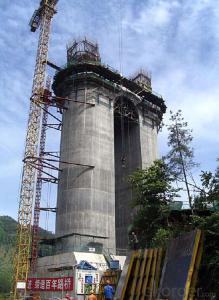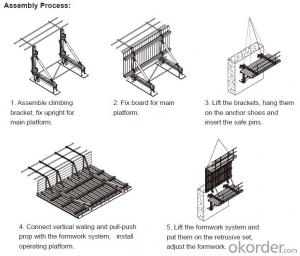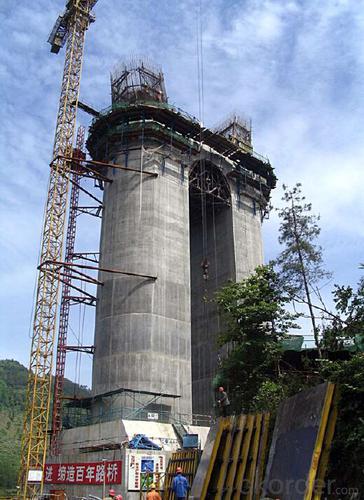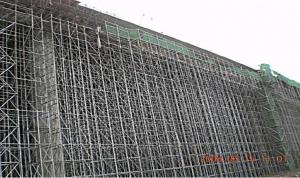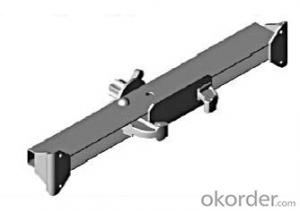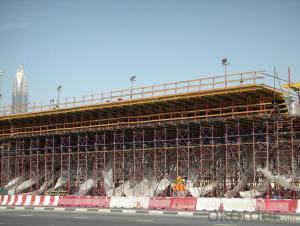Auto climbing bracket ACB100&ACB50 for formwork and scaffolding systems
- Loading Port:
- Tianjin
- Payment Terms:
- TT OR LC
- Min Order Qty:
- 50 m²
- Supply Capability:
- 1000 m²/month
OKorder Service Pledge
OKorder Financial Service
You Might Also Like
Auto-climbing Bracket ACB100 & ACB50
The power of the auto-climbing formwork is the hydraulic system, which includes the oil cylinder
and two commutators. The commutators can control the climbing of climbing rail and the bracket.
The steel rail and the bracket can inter-climbing, so the whole system will climb up steadily.
Cranes are not needed during the construction. It’s easy to operate, highly efficient and safe. It’s
the best choice for the construction of high buildings and bridges.
There are mainly two types of standard auto-climbing brackets, ACB-50 and ACB-100, the figure
means the push power of cylinder with unit of KN.
Characteristics:
◆ Perfect load bearing anchor system
Anchor system is the most important supporting part. The system is made of five parts shown
below. Thereinto, tensile bolt, V-climbing cone and washer can be taken out for reusing after the
concrete pouring finished.There are two kinds of anchor systems,A & B. A is matched with single
anchor shoe and B is matched with double anchor shoe.
◆ Crane-independent
Crane-independent forming, striking and climbing speeds up the work procedures on the
construction site and also makes them independent of each other. This means the planned
sequences can be maintained along with guaranteeing high productivity levels. The crane can
therefore be used for other tasks.
Hydraulic system is mainly made of two commutators,
oil cylinder and power distribution system.The
commutators can control the climbing of climbing rail
and bracket.
◆ High bearing capacity and safe
The stable working platforms are able to carry large loads, e.g. the storage of reinforcing steel
for the next climbing section. Generously-sized working platforms, the well thought-out design for
handling very high wind loads and the patented control function of the climbing mechanism are
some of the special details contained within the comprehensive safety concept.
◆ Platforms adjusted to suit the angle of inclination
The horizontal working areas thus created provide safe and comfortable conditions for
reinforcement work, shuttering and striking, concreting and finishing.
◆ The ACB formwork system can climb not only vertically but also slantways, the largest angle is
18 degrees.
◆ The system can climb up wholly or separately. The climbing process is steady, synchronous
and safe.
◆ The bracket will not fall to the ground until the construction is finished, the field will be saved
and the impacting breakage will be reduced (especially the panel).
◆ The system will furnish omnidirectional platform, the construction organizations don’t need to
set up additional operation platform.
◆ The error of structure construction is small and easy to correct.
◆ The climbing speed is fast, the construction course will be quickened.
◆ The formwork can climb itself and cleaning work can be done in the same situs , the used times
of tower crane will be greatly reduced.
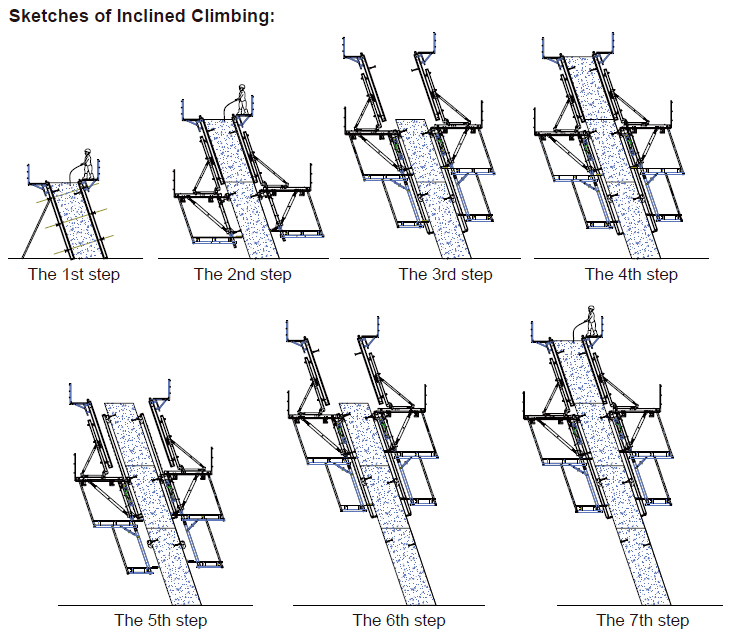
- Q: The wooden plank road construction, the steel structure and the template pavement, the railing installation all construction labor cost to want how many money? Or how much a square?
- Under normal circumstances, in accordance with the plant area of about 30--60 per square meter. For reference only.
- Q: Is steel formwork suitable for projects with limited construction space?
- Yes, steel formwork is suitable for projects with limited construction space. Steel formwork is known for its versatility and adaptability, allowing it to be easily customized to fit into smaller spaces. Additionally, steel formwork is durable and can withstand heavy loads, making it a reliable choice for projects with limited space where structural integrity is crucial.
- Q: What types of concrete structures can be built using steel formwork?
- Steel formwork is a versatile construction tool that has the capability to build a variety of concrete structures. Some examples of common structures that can be created using steel formwork are: 1. Walls: Steel formwork can be utilized to construct both retaining walls and load-bearing walls. It provides the necessary support to hold the concrete in place until it sets and gains its strength. Steel formwork allows for the construction of walls with different shapes and sizes, such as straight, curved, or inclined walls. 2. Columns: For constructing columns of varying heights and diameters, steel formwork is the ideal choice. It offers a strong and stable framework to hold the concrete in place while it cures. Steel formwork can be easily adjusted to accommodate various column dimensions, making it suitable for both small and large-scale construction projects. 3. Beams and Slabs: Beams, which are horizontal structural members that support the structure above, and slabs, which form the floors or roofs of a building, can also be constructed using steel formwork. Steel formwork allows for the construction of beams and slabs with different shapes and sizes, including rectangular, circular, or even curved configurations. 4. Bridges and Tunnels: Bridges and tunnels commonly rely on steel formwork during construction. It enables the creation of complex structural elements with high precision and accuracy. Steel formwork systems are easily transportable and can be assembled on-site, making them an efficient choice for bridge and tunnel construction projects. 5. Staircases: Steel formwork can also be used to build staircases with various configurations, such as straight flights, spiral stairs, or helical stairs. It provides the necessary support to create the desired shape and geometry of the staircase. Steel formwork ensures the structural integrity of the staircase while the concrete sets and hardens. In summary, steel formwork is a flexible and durable solution for constructing a wide range of concrete structures. Its adaptability, strength, and ease of use make it an ideal choice for various construction projects, including residential buildings and large-scale infrastructure developments.
- Q: How does steel formwork affect the overall construction waste generation?
- There are several ways in which steel formwork can significantly reduce construction waste. First and foremost, steel formwork is reusable, allowing it to be used multiple times for various projects. Unlike traditional timber formwork, which is often disposed of after a single use, steel formwork can be dismantled, transported, and reassembled for future construction projects. This greatly reduces the amount of waste generated from formwork materials. In addition, steel formwork is more durable and resistant to damage compared to other types of formwork. It can withstand greater pressure and is less likely to deform or break during the construction process. As a result, there is less need for frequent replacements and repairs. This further minimizes waste generation. Moreover, steel formwork enables precise and accurate construction, leading to less material wastage. Its rigid structure ensures that concrete is poured and cured in the desired shape and dimensions, eliminating the need for excessive concrete pouring or trimming. This reduces unnecessary material usage and decreases the amount of construction waste produced. Furthermore, cleaning and maintaining steel formwork is easier compared to other formwork materials. It can be cleaned and repaired more efficiently, reducing the chances of material degradation and the need for replacement. This not only prolongs the lifespan of the formwork but also reduces waste from discarded or damaged formwork materials. Overall, the use of steel formwork in construction projects has a positive impact on waste generation. Its reusability, durability, accuracy, and ease of maintenance contribute to minimizing construction waste, making it a more sustainable option for formwork in the construction industry.
- Q: Are all steel plates used for beam slab prefabrication
- If all steel plates are used for precast beam and slab, the shape of prefabricated components should be adopted
- Q: Does steel formwork require any special tools for installation and removal?
- Yes, steel formwork typically requires special tools for both installation and removal. Since steel formwork is heavy and rigid, it often necessitates the use of cranes, forklifts, or other lifting equipment to position the formwork panels in place. Additionally, special tools such as spanners, hammers, and wedges are commonly used to secure the formwork panels tightly together and ensure stability during concrete pouring. When it comes to removal, steel formwork usually requires the use of power tools like grinders or cutting torches to disassemble and separate the formwork from the hardened concrete. These tools are necessary to cut through any welds or bolts that hold the formwork in place. It is important to exercise caution and follow safety protocols while using these tools. Overall, due to the heavy and sturdy nature of steel formwork, special tools and equipment are typically required for both installation and removal to ensure efficient and safe execution of the formwork process.
- Q: Can steel formwork be used for school construction projects?
- Indeed, school construction projects can make use of steel formwork. Steel formwork, being a resilient and versatile construction material, is capable of withstanding the immense loads and pressures encountered within school buildings. It provides a robust and steadfast framework for pouring concrete, thus ensuring the structural integrity of the construction. Furthermore, steel formwork is designed to be reusable, thereby offering a cost-effective option for school construction projects. Its adaptability allows for the creation of various shapes and sizes, catering to the distinct architectural designs typically found in school buildings. Moreover, steel formwork facilitates faster construction times when compared to traditional timber formwork, enabling the swift completion of school projects. In summary, steel formwork represents a fitting and dependable choice for school construction projects.
- Q: How does steel formwork contribute to the overall quality of the concrete finish?
- Steel formwork contributes to the overall quality of the concrete finish by providing a sturdy and accurate mold for the concrete to be poured into. It ensures that the concrete is poured and shaped precisely, resulting in a smooth and even finish. The durability and strength of steel formwork also prevent any deformation or movement during the curing process, leading to a more durable and long-lasting concrete structure.
- Q: What is the 86 series steel formwork
- Steel template (also called undismantled Mould Network) can replace the wood template, significantly reduced usually with wood, plywood, steel plate or other traditional sealing template on the pore water pressure and the pressure in the bubble concrete elimination; steel template (undismantled Mould Network) structure of concrete casting, forming an ideal rough interface. Do not need to rough cutting operations can enter the next construction processThe utility model can be placed before installing the reinforcing steel bar, and can also be placed after installing the reinforcing steel bar. If it is installed before the installation of steel, easy installation and easy to install; concrete pouring process can be visually monitored, thereby reducing the risk of the emergence of pores and honeycomb structure and other phenomena.
- Q: How does steel formwork affect the aesthetics of a building?
- The aesthetics of a building can be significantly impacted by steel formwork in various ways. Firstly, steel formwork allows for the creation of complex and intricate designs, resulting in visually appealing architectural elements. The flexibility and strength of steel enable the construction of unique shapes, curves, and patterns that enhance the overall aesthetics of the building. Moreover, steel formwork gives concrete surfaces a smooth and seamless finish. This contributes to a more refined and polished appearance, especially when compared to other formwork materials like timber or plastic. The absence of visible joints, seams, or imperfections on the concrete surfaces enhances the overall look of the building. Additionally, steel formwork offers the advantage of reusability, leading to cost savings and reduced waste. This economic benefit allows architects and designers to allocate more resources to enhance the building's aesthetics, such as incorporating high-end finishes or unique decorative elements. Furthermore, steel formwork ensures a high level of accuracy and precision during the construction process. This precision guarantees that the final structure is aligned and symmetrical, enhancing the overall visual harmony of the building. Straight lines, sharp corners, and consistent dimensions can be achieved with steel formwork, resulting in a visually pleasing and harmonious architectural design. Lastly, the durability and strength of steel formwork contribute to the long-term aesthetics of the building. Steel formwork can withstand harsh weather conditions, resist corrosion, and maintain its structural integrity over time. This durability ensures that the building's aesthetics remain intact for an extended period, enhancing its overall appeal and value. To conclude, steel formwork has a positive impact on the aesthetics of a building by enabling complex designs, providing a smooth finish, allowing for precision and accuracy, offering cost savings, and ensuring long-lasting visual appeal.
Send your message to us
Auto climbing bracket ACB100&ACB50 for formwork and scaffolding systems
- Loading Port:
- Tianjin
- Payment Terms:
- TT OR LC
- Min Order Qty:
- 50 m²
- Supply Capability:
- 1000 m²/month
OKorder Service Pledge
OKorder Financial Service
Similar products
Hot products
Hot Searches
